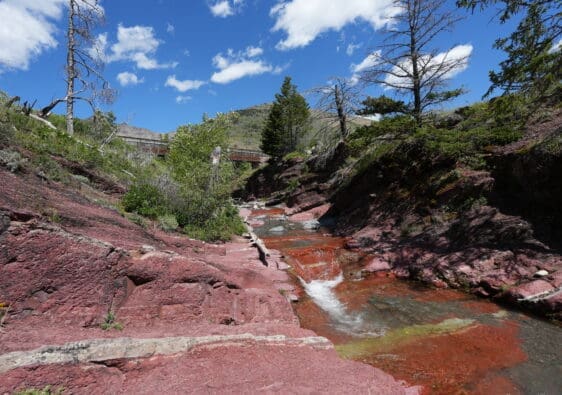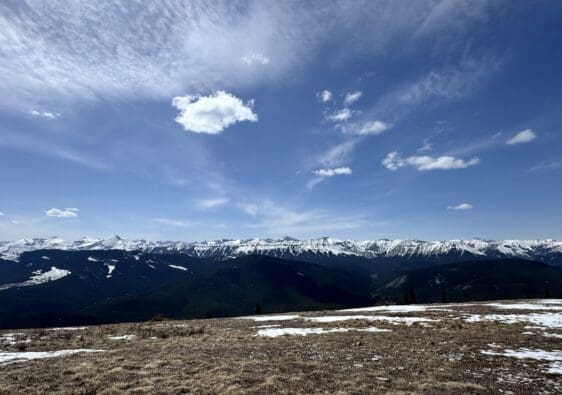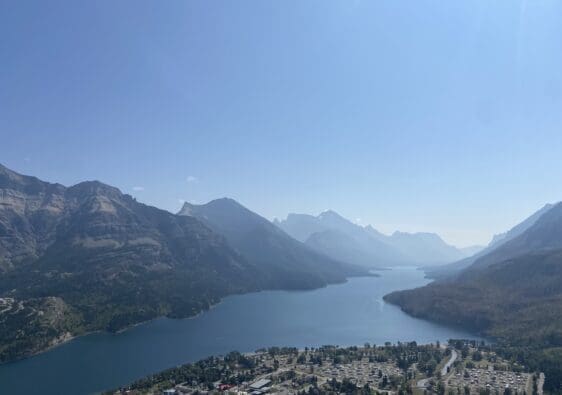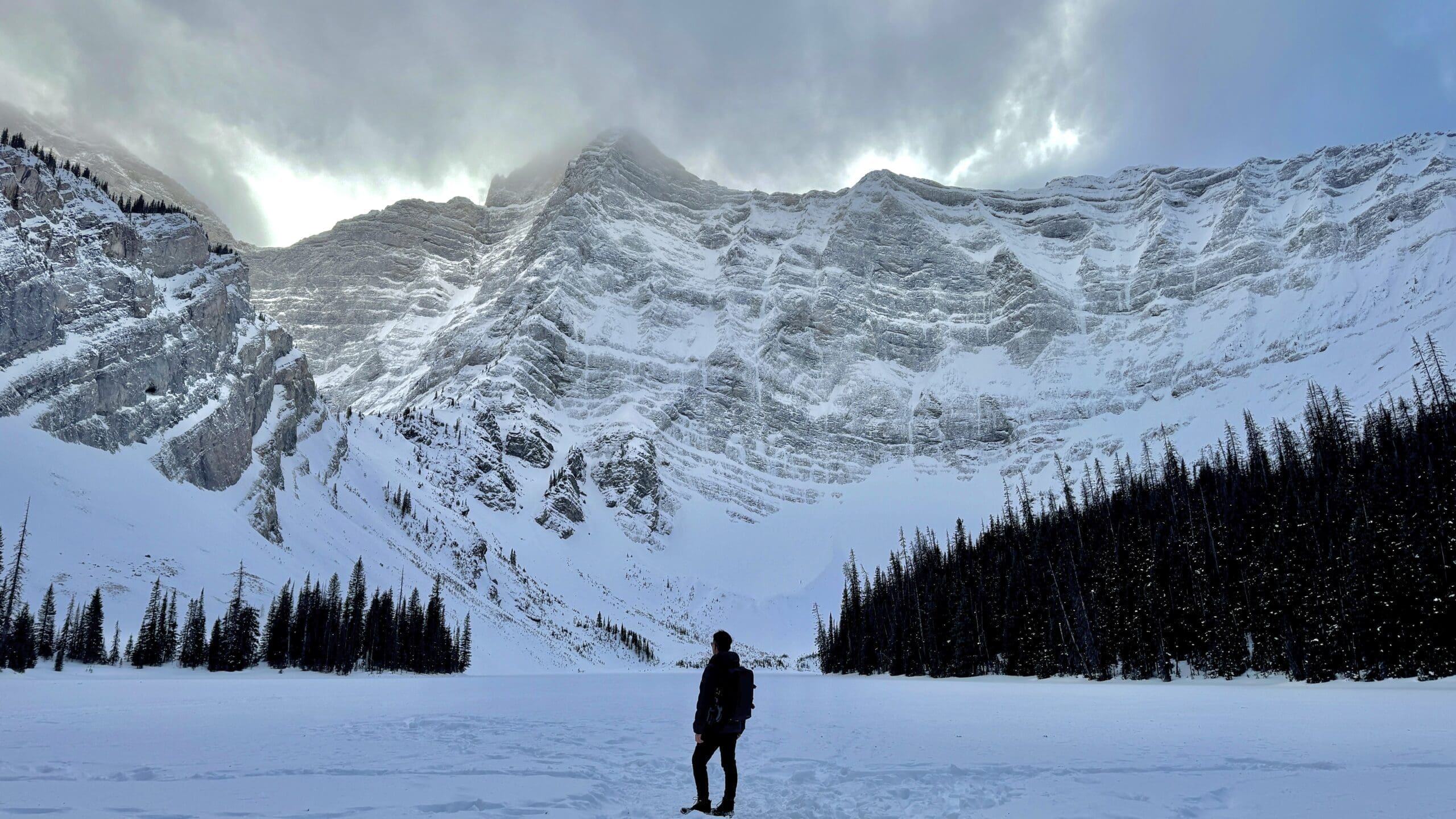If you’re looking for a hike that combines towering cliffs, glaciers, waterfalls, wildflowers, and even ancient fossils, the Stanley Glacier Trail in Kootenay National Park should be at the top of your list. This moderately challenging trail climbs through a post-wildfire forest into a dramatic alpine valley beneath the Stanley Glacier, offering hikers a true taste of the Rockies’ diversity.
Discovery Pass
Parks Canada Discovery Pass is compulsory visiting National Parks across Canada. You can purchase online beforehand, or purchase the pass when you visit National Parks at specific Park Gate.
You can be fined if you did not show your Discovery Pass or Day Pass when visiting Canadian National Parks.
Overview of the Stanley Glacier Trail
The Stanley Glacier Trail is a moderate half-day hike that features open valleys, waterfalls, cliff faces, and a glacier viewpoint. The first half is mostly switchbacks, while the second half opens into a stunning subalpine meadow beneath the glacier.
- Trail Length: 10.8 km (round trip)
- Elevation Gain: ~610 meters
- Duration: 4 – 5 hours
- Difficulty: Moderate
- Trailhead: Stanley Glacier Trailhead
This trail is well-signed, incredibly scenic, and offers spectacular photo ops at every turn, especially during wildflower season.
How to Get to the Stanley Glacier Trail Parking
The Stanley Glacier Trailhead is located along the Banff–Radium Highway (Highway 93 S) in Kootenay National Park, about halfway between Banff and Radium Hot Springs.
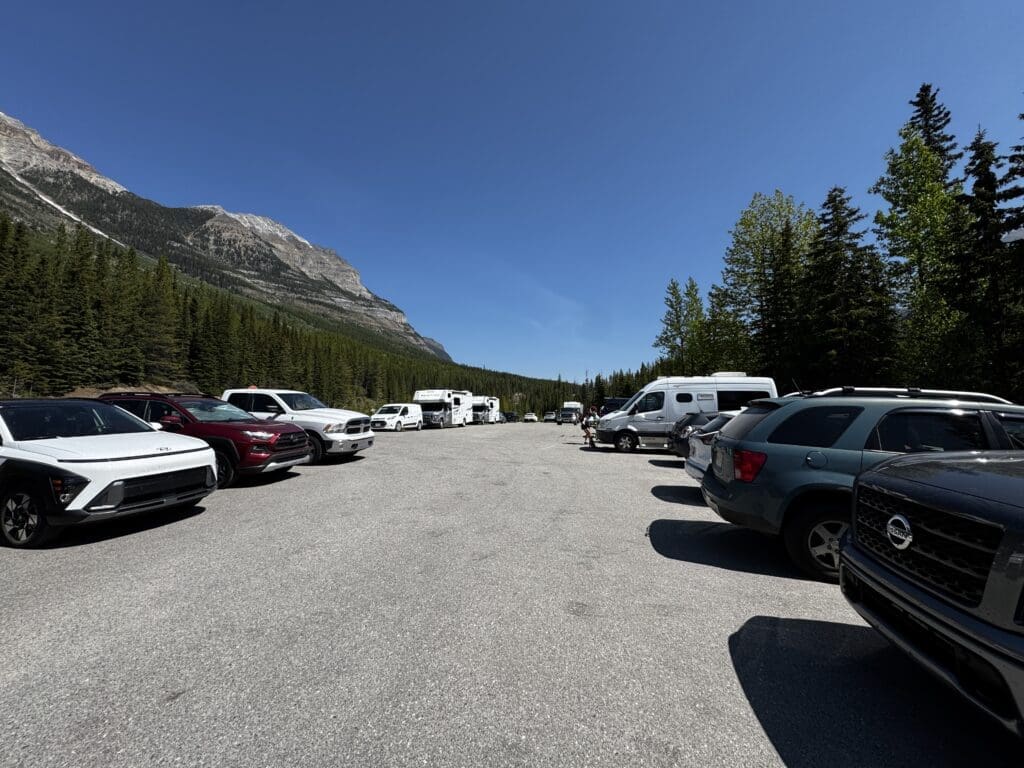
Driving Directions:
- From Banff: Drive west on Highway 1, turn south onto Hwy 93 S at Castle Junction, and drive 13 km to the Stanley Glacier Trailhead.
- From Radium: Head north on Hwy 93 for ~85 km.
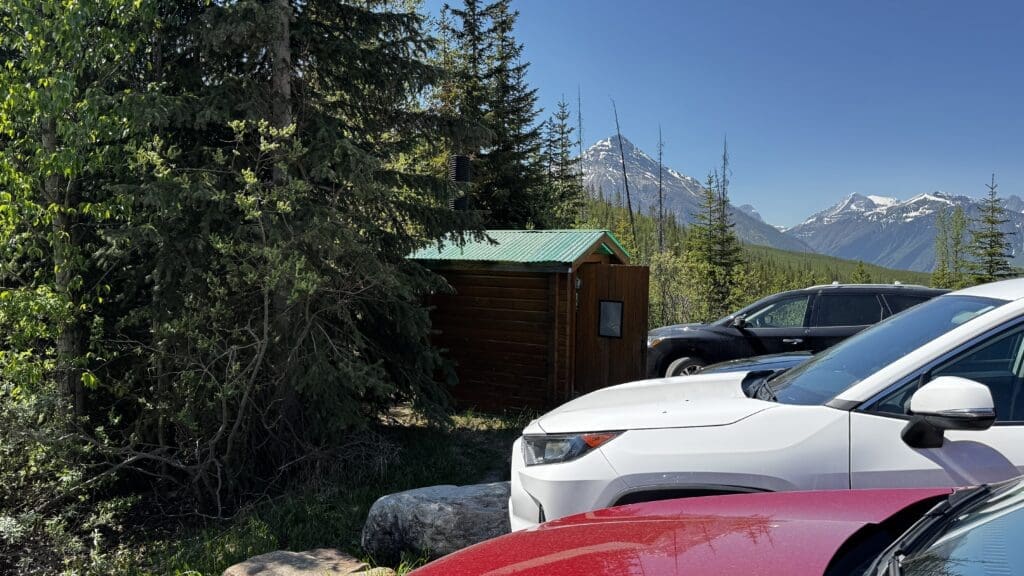
Parking Tips:
- The Stanley Glacier Day Use Area has a paved parking lot and toilets.
- Parking is free, but a valid Parks Canada pass is required.
- The lot fills up quickly in July and August, so arrive early to avoid peak heat and crowds.
Pro tip: Early morning hikes offer the best lighting and a greater chance of spotting wildlife in the forested sections.
Trail Description
Starting the Stanley Glacier Trail

The trailhead is not obvious. When the parking lot is full of cars, it can be covered by cars. The narrow trailhead is located close to the toilet.
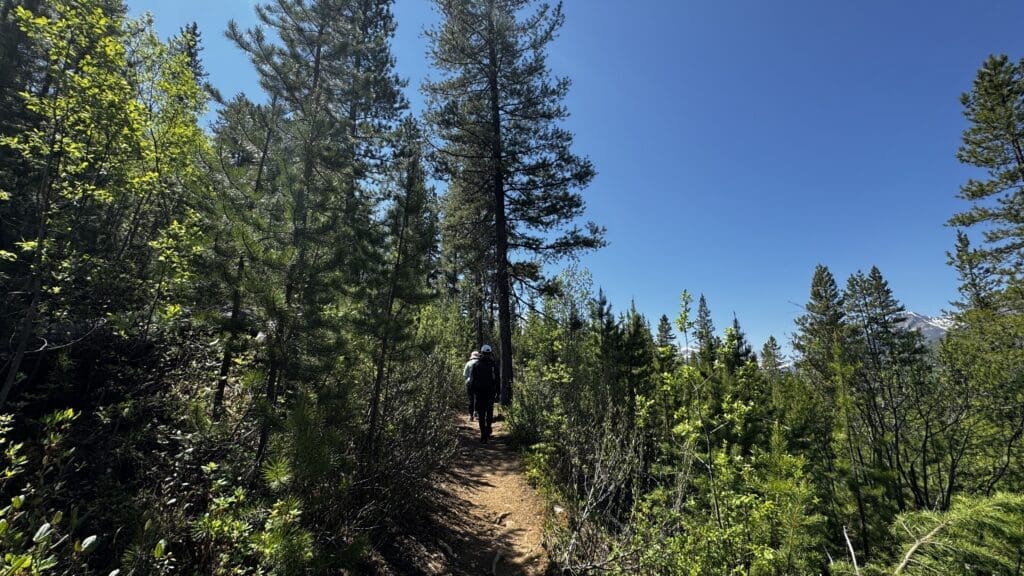
The first 2 km consists of steady, moderate uphill switchbacks on a well-maintained gravel trail.
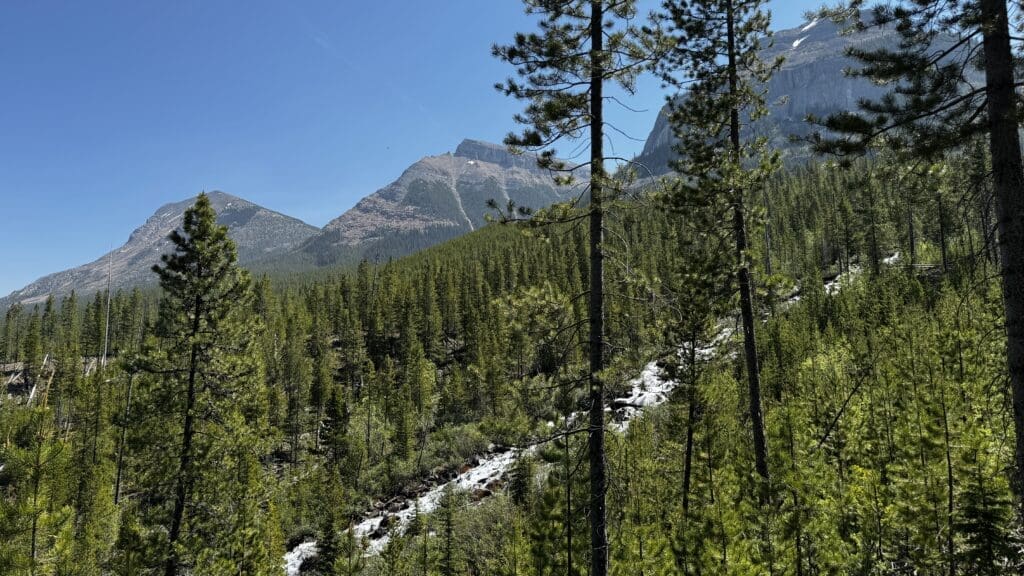
There’s a long waterfall nearby at a rest point or viewpoint.
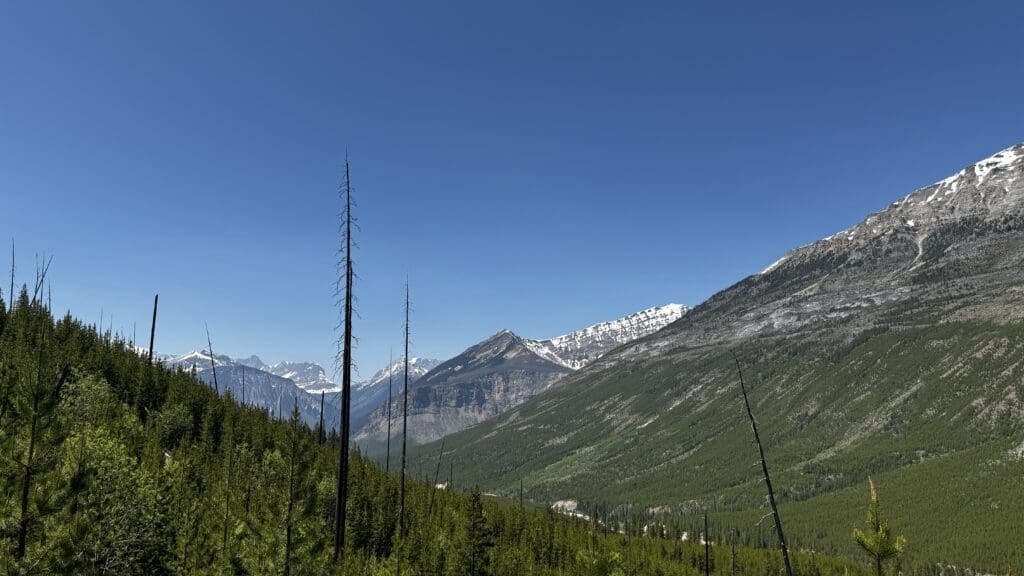
Along the trail, you will see a forest that burned in the 2003 Vermilion Pass wildfire.
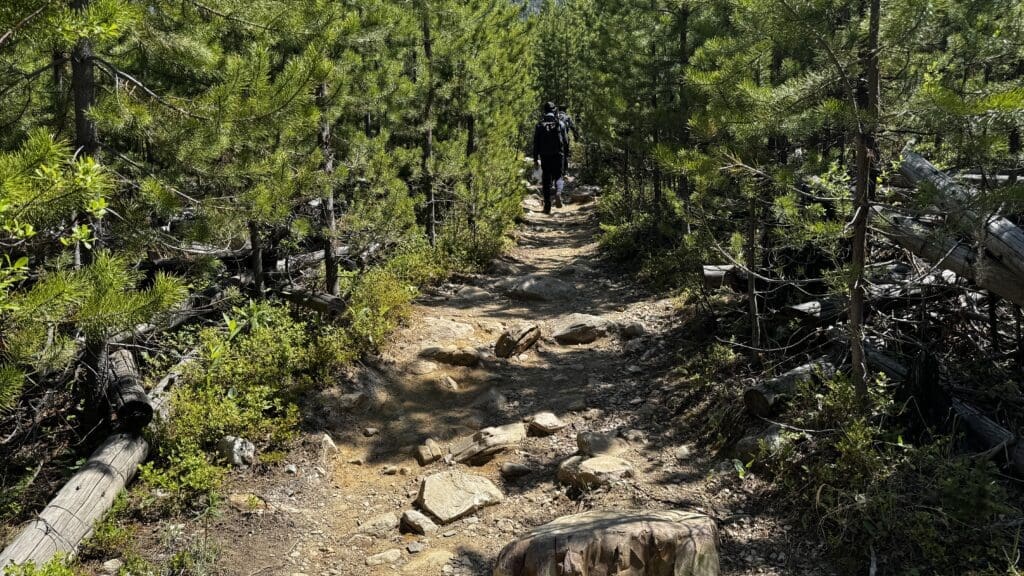
The trail is not well-covered by trees, the sun is very strong, put on your sunscreen and sunglasses!
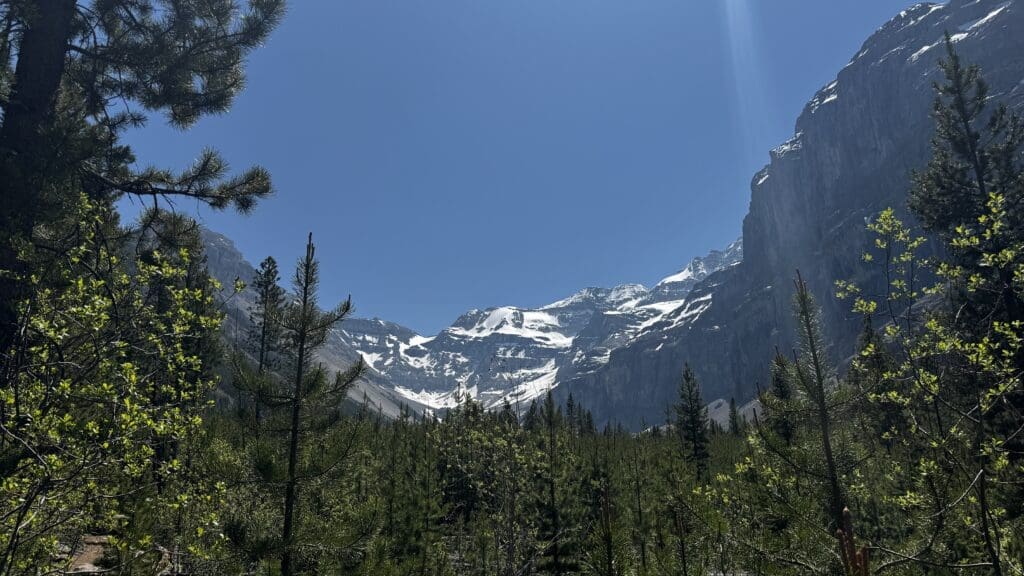
Soon, the trail levels out into a stunning valley surrounded by sheer limestone cliffs, waterfalls, and distant views of Stanley Glacier perched high above.
Midway to Stanley Glacier
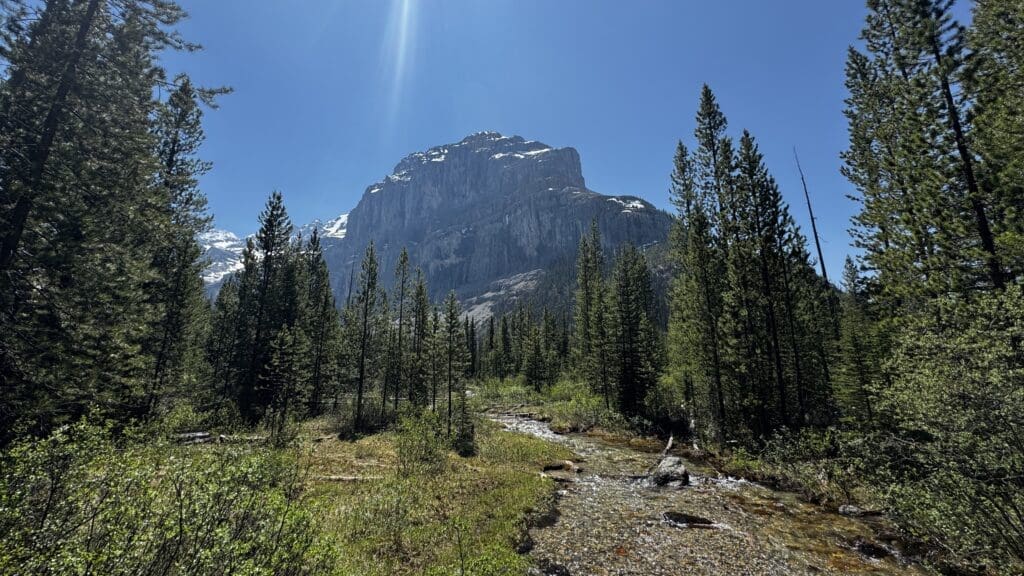
After the gradual incline switchbacks, you will encounter a creek. Take a break here and cool yourselves down! I wish I had brought my slippers with me.
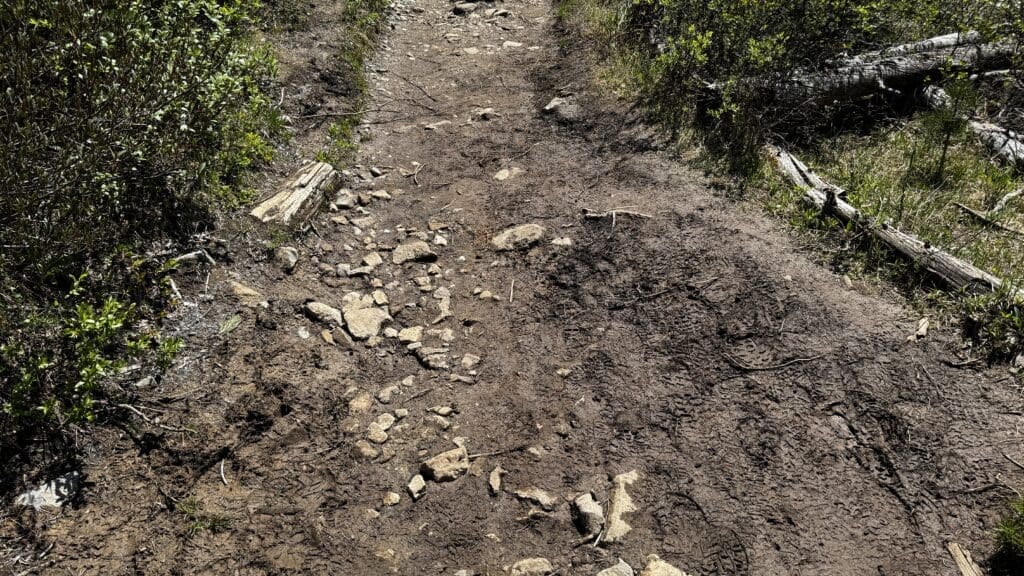
There is a section of the trail that is a bit muddy. When we headed back to the park in the evening, this muddy section became much larger. Remember to wear waterproof hiking boots!
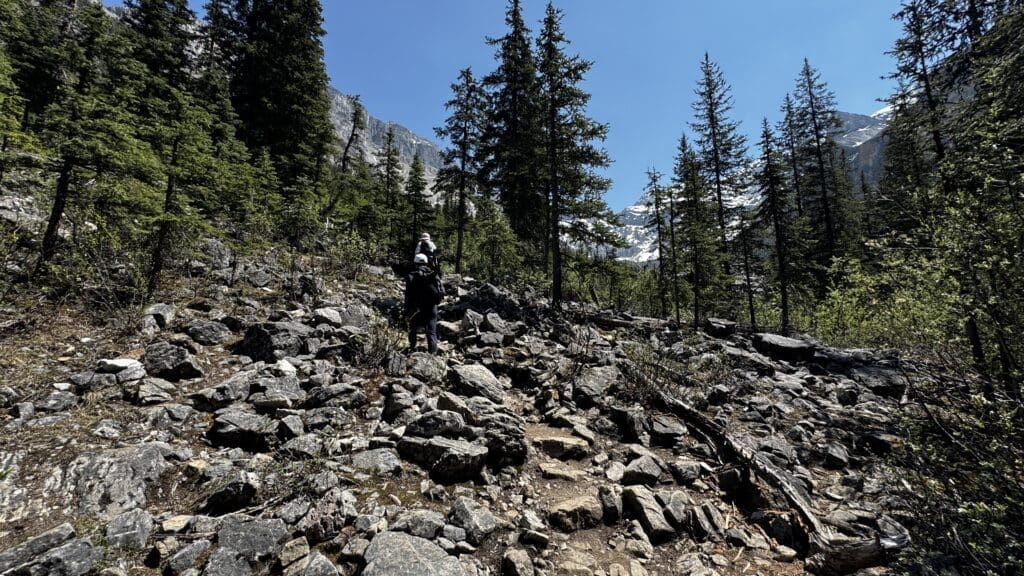
Highly recommend you to bring your trekking poles along with you. The rocky terrain along the Stanley Glacier Trail can be tough, trekking poles will definitely help you balance and make the hike easier.
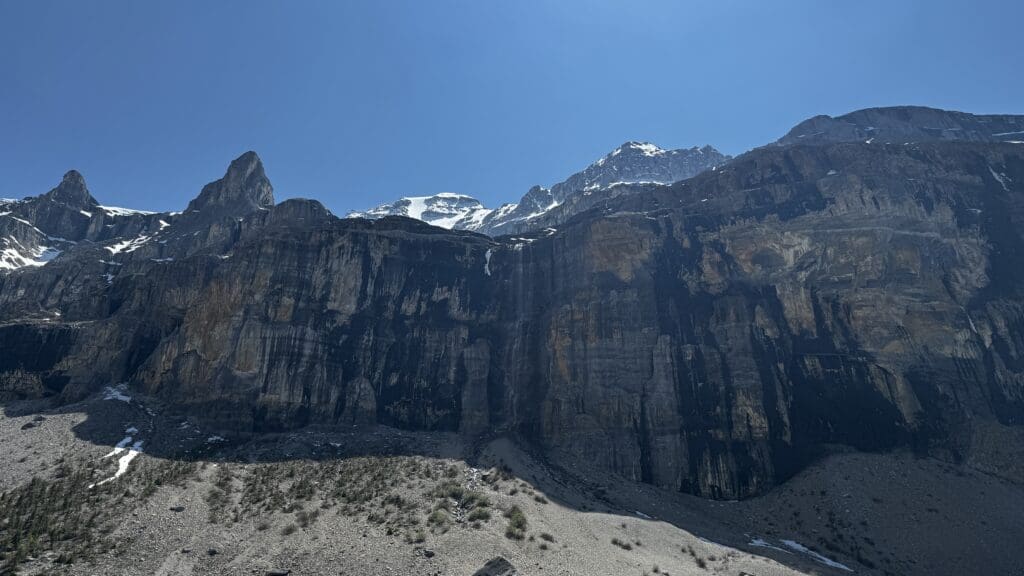
Look around along the trail, don’t miss the beautiful scenery.
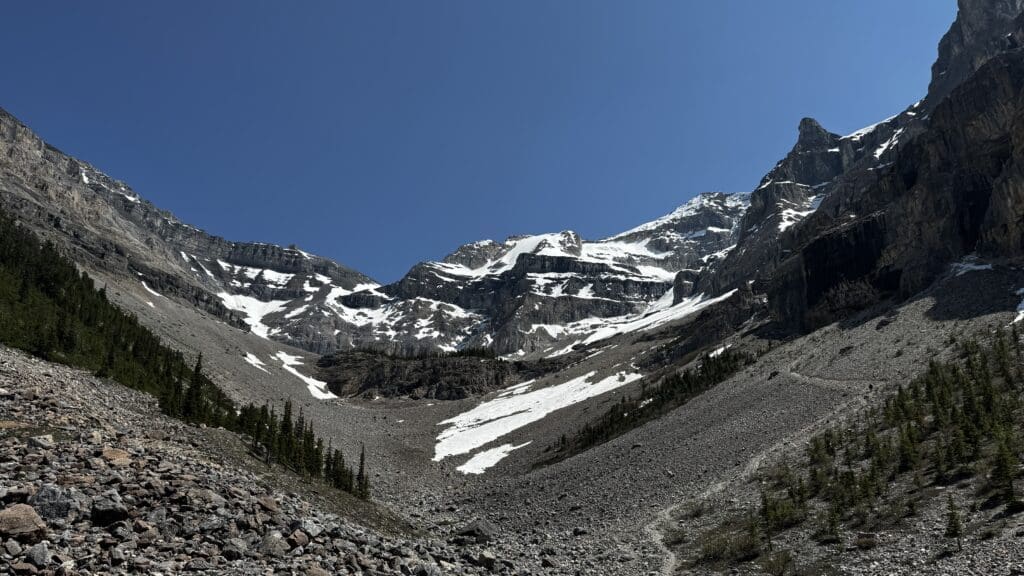
The official trail ends here, but hikers can explore further into the boulder field for better glacier views.
Bonus: Guided hikes to Burgess Shale fossil beds run through Parks Canada in the summer, this area is world-famous for its preserved prehistoric sea life.

We were too early to join the guided tour in June, so we tried to hunt for fossils ourselves at the end of the trail. We actually found some among so many rocks, it was so much fun! Just remember you are not permitted to take away any rocks with you in the national park.
Reaching the Final Loop
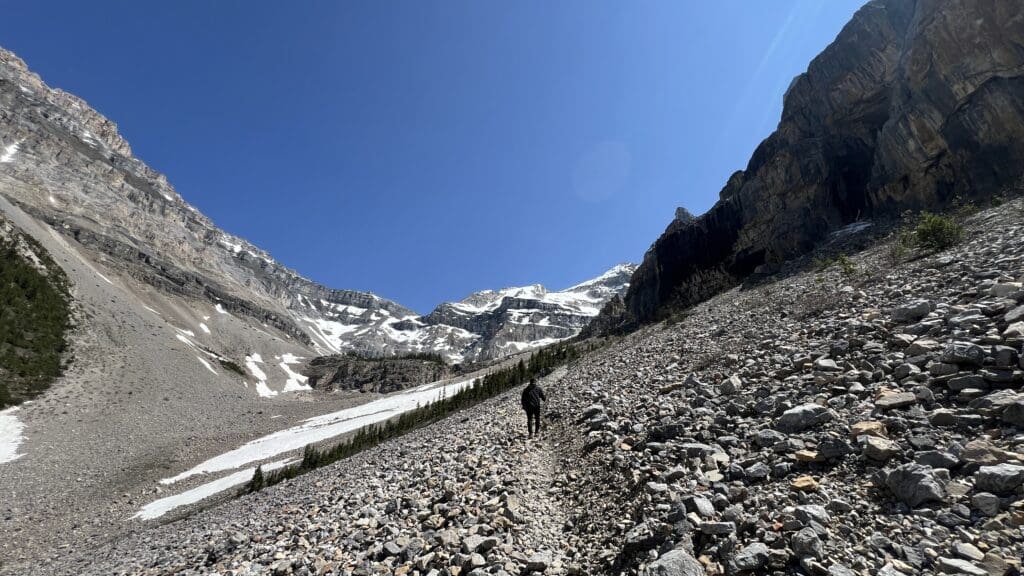
The loop is not well maintained and is full of rocks. it is not recommended for beginners. If you decide to take on this challenge, be sure to bring hiking poles and hike with friends.
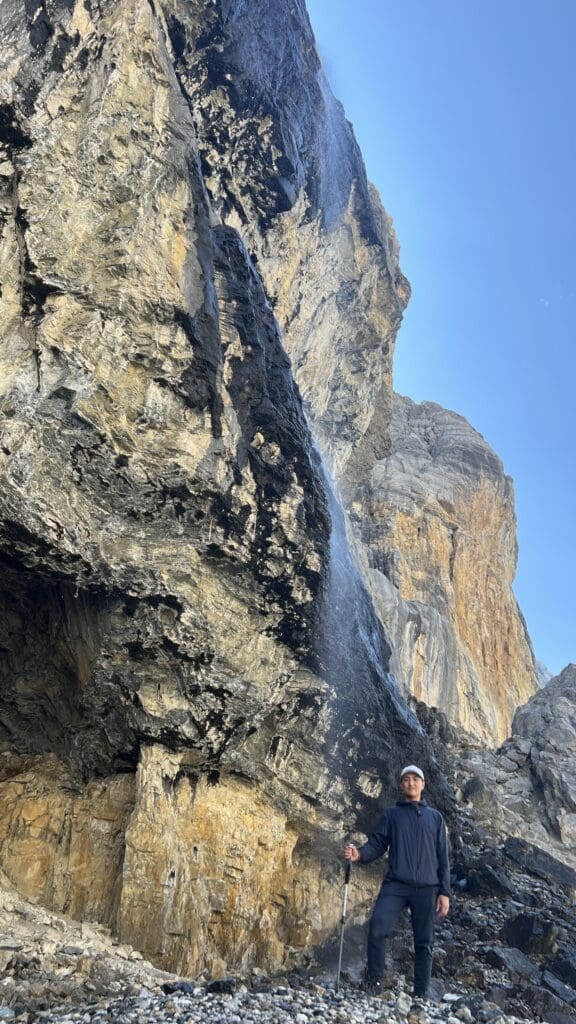
After a long, steady, and steep climb, you will reach a small cave with a waterfall. Pause for a rest and capture a photo before continuing your hike.
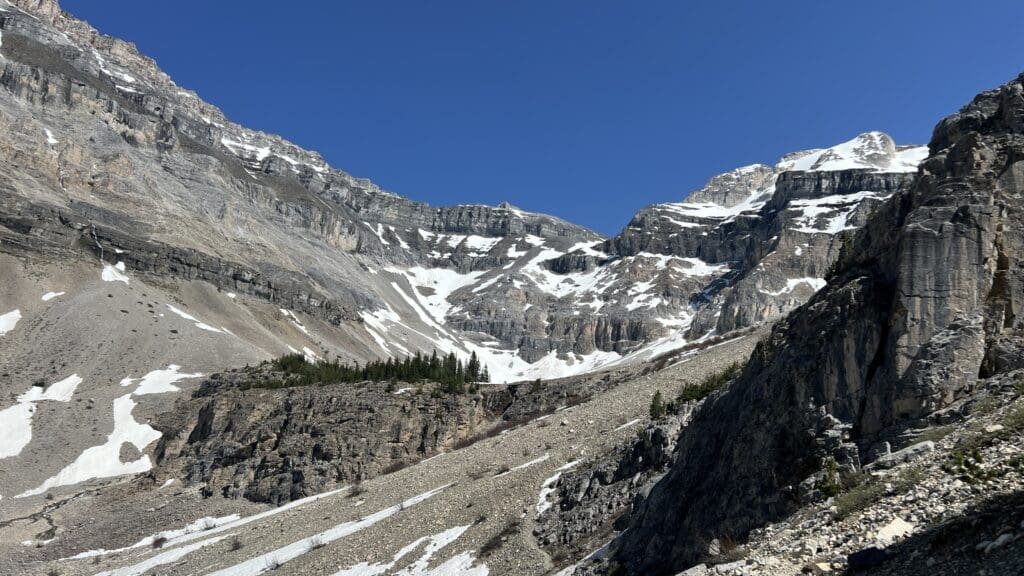
Take in the stunning panoramic views of the valley and the glacier.
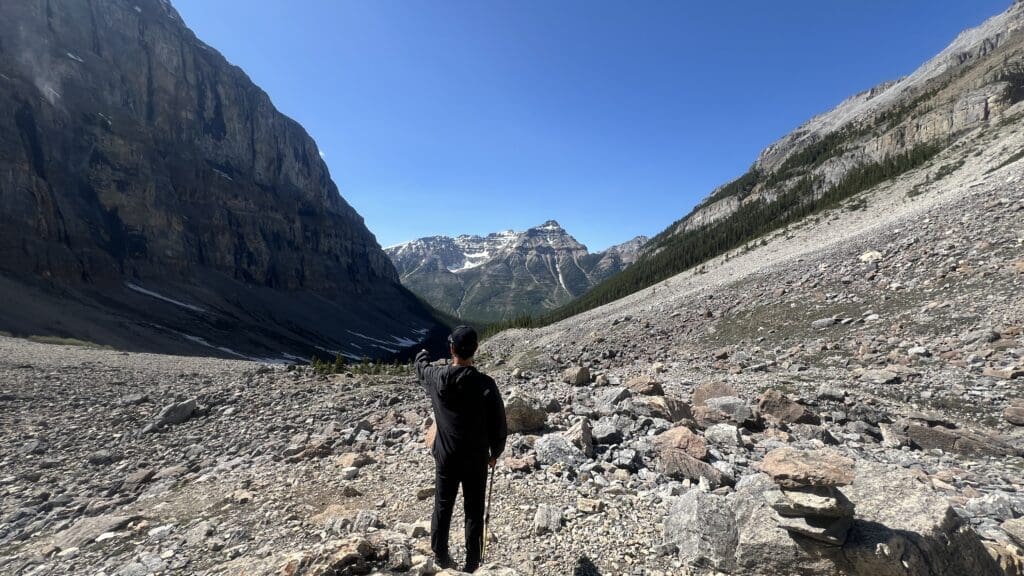
You can follow the trail to finish the loop or head back if needed – it all depends on the situation.
Essential Gear
While the trail is accessible and well-marked, rocky terrain, exposure, and changing weather mean proper gear is essential for a safe and enjoyable hike.

Trekking poles
Helpful especially when going downhill.
Pro tip: Remember to bring bear spray because Kootenay is an active grizzly territory.
Best Time to Visit Stanley Glacier
The trail is best hiked from late June through early October, once the snow has melted and the trail is fully accessible.
June to July
Peak wildflower season with lush greenery and fast-flowing waterfalls.
August
Glacier views are clearest, and it’s prime hiking weather with fewer bugs.
September to October
Crisp air, golden light, and quieter trails before the first snowfall.
Avoid visiting before mid-June, as snow lingers on the upper trail and the area may be muddy or partially frozen.
Pets and Kids-Friendly?
Yes, the Stanley Glacier Trail can be enjoyed by older kids and well-conditioned pets. While the first half is gradual, the second half is more exposed and rocky, making it better suited for families who are comfortable with moderate hikes.
For Kids
Kids aged 8 and up who enjoy hiking will likely love this trail, especially the waterfalls, rocks, and glacier views.
The open landscape after the burn offers rare visibility, and older children may enjoy looking for fossils or spotting marmots.
For Pets
Dogs are allowed on leash, and the first part of the trail is shaded and wide enough for most dogs to enjoy.
The boulder-strewn area near the glacier can be tough on paws, so bring booties or check for cuts afterward.
This trail is best suited for adventurous families and pets who have done a few hikes before and can manage elevation and uneven terrain.
Nearby Adventure
Stanley Glacier is perfectly positioned for a day packed with nature, or as a launchpad for further exploration in Kootenay and Banff National Parks. Here are some great options to combine with your hike:
1. Marble Canyon
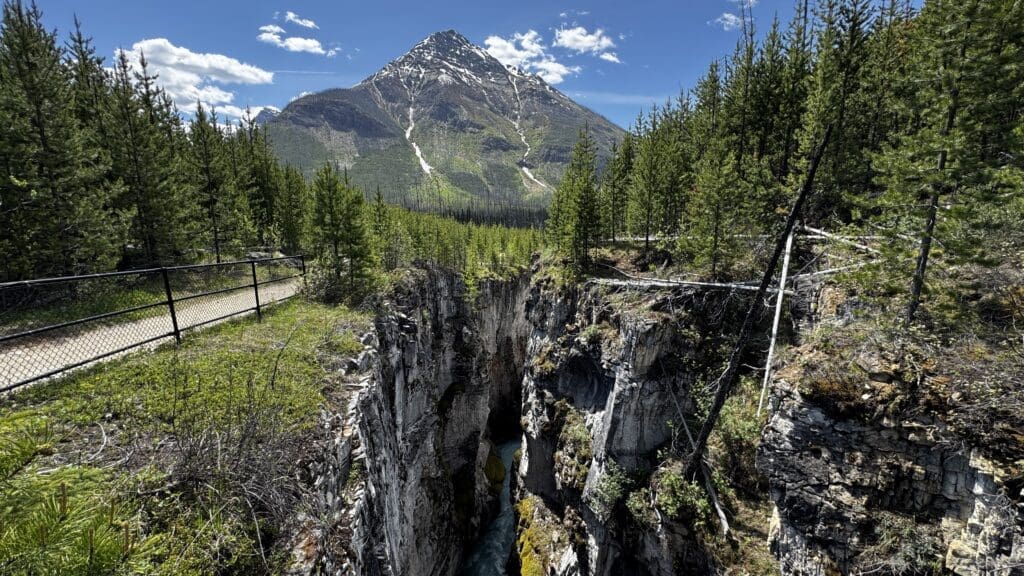
Just a few minutes south on Hwy 93, this short and scenic trail features bridges and narrow canyon views carved by the Tokumm Creek. Great for a relaxing post-hike walk.
2. Paint Pots Trail
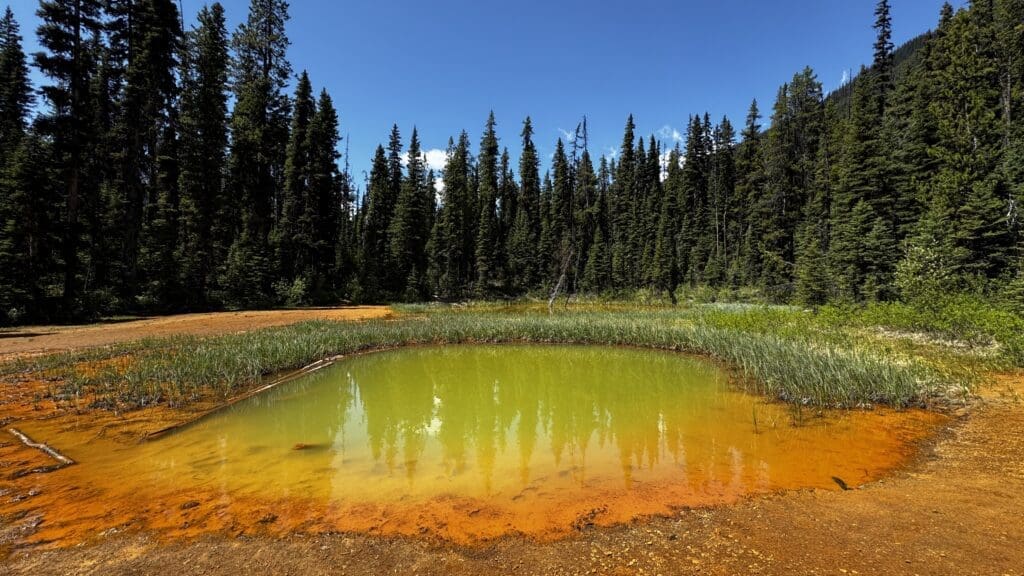
Another short hike along Hwy 93 featuring iron-rich ochre springs and unique colored pools used historically by Indigenous peoples. A quick and educational stop.
3. Boom Lake Trail
Located just up the road in Banff NP, this moderate 10 km trail leads to a secluded alpine lake, perfect for those wanting a full-day hike after Stanley Glacier.
4. Radium Hot Springs
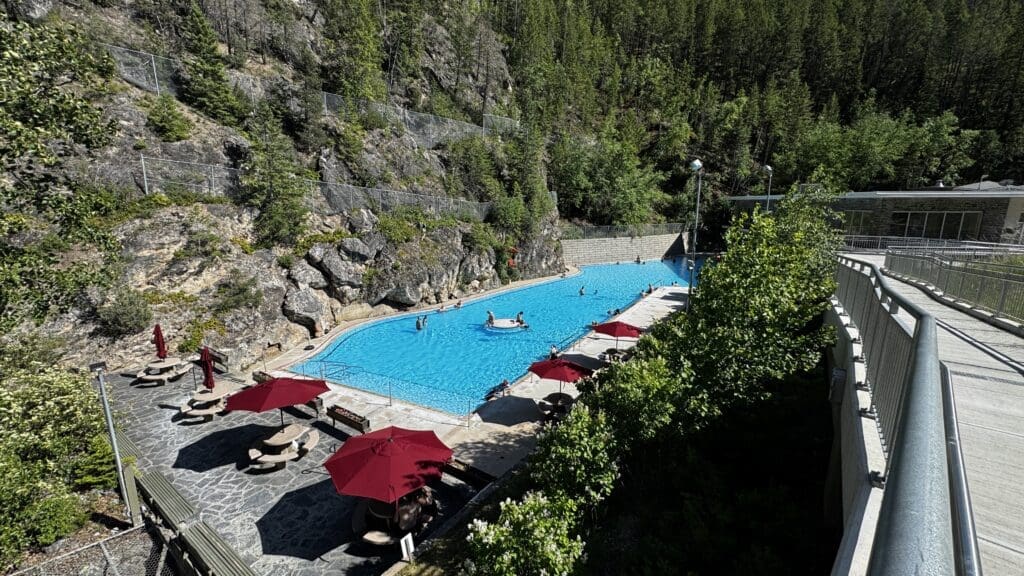
Drive south to Radium and soak your muscles in these natural mineral pools, surrounded by rock cliffs. Great after a hike to ease sore legs.
5. Castle Junction & Highway 1 Hikes
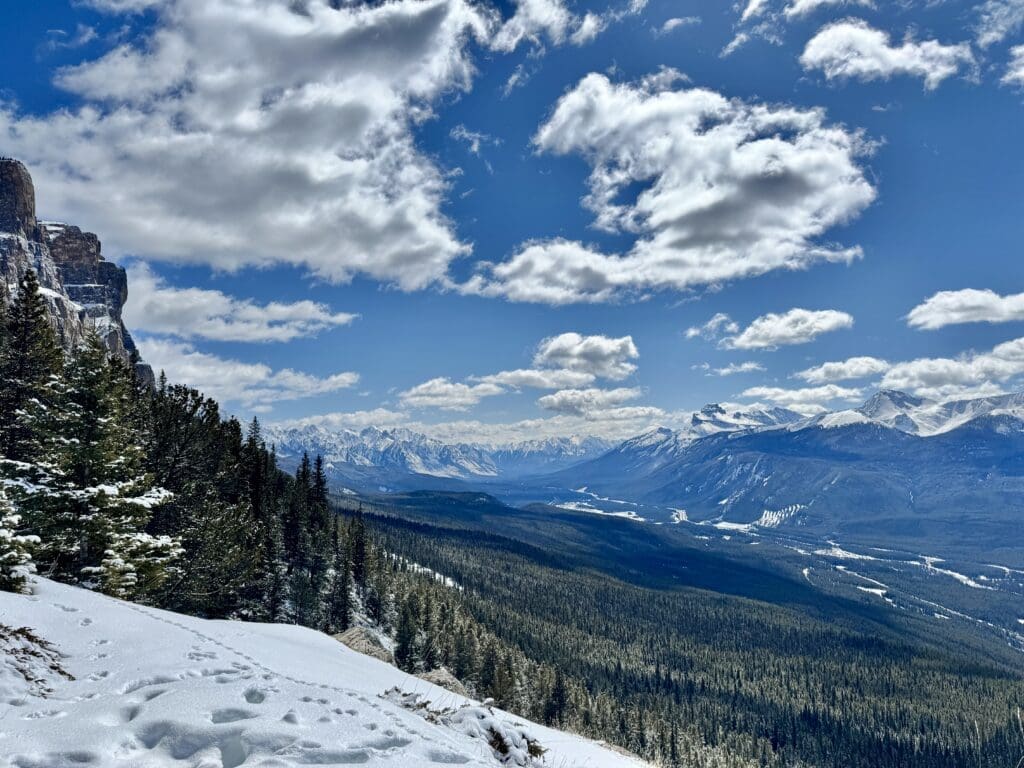
If you’re continuing east toward Banff, explore Castle Lookout, Silverton Falls, or Rockbound Lake for more trail variety and glacier-carved terrain.
Accommodations
Whether you’re staying near Radium, Banff, or Field, there are great places to rest and recharge after a hike on the Stanley Glacier Trail.
| Accommodation | Type | Highlights | Price Range |
|---|---|---|---|
| Storm Mountain Lodge | Historic Cabins | Historic log cabins, gourmet dining, fireplace, no Wi-Fi, eco-conscious | $$$ |
| Prestige Radium Hot Springs Resort | Resort | Indoor pool & hot tub, fitness centre, spa services, restaurant & lounge, business centre, board games & sports gear, coin laundry, EV chargers, dog‑friendly rooms. | $$-$$$ |
| Celadon Lodge | Lodge | Breakfast included, A/C, Wi‑Fi, kitchenettes, EV chargers, BBQ and picnic facilities, pet‑friendly rooms | $$ |
| Mountain Springs Motel | Motel | A/C, Wi‑Fi, kitchenettes, complimentary coffee, BBQ area, sundeck, gazebo, seasonal operation April–October | $ |
| Inn on Canyon | Inn | A/C, Wi‑Fi, flat-screen TVs, complimentary hot breakfast, BBQ access, hot spring towel borrowing, adults-only unless pre-arranged | $$ |
| Banff Townsite Hotels | Hotels & Inns | Wide range from budget to luxury, dining and shopping nearby | $$-$$$ |
| Marble Canyon Campground | Campground | Quiet, forested campground closest to trailhead | $ |
Staying nearby allows for early morning trail access and stunning sunrise or sunset photo ops in the Vermilion Valley.
FAQs
Do I need a permit to hike Stanley Glacier Trail?
You don’t need a hiking permit, but a Parks Canada Discovery Pass is required to access Kootenay National Park.
Is the trail suitable for beginners?
The trail is moderate. Beginners in decent shape can handle it, but expect steady uphill hiking and uneven surfaces.
Can I hike this trail in winter?
The trail is not maintained in winter. Snowshoeing is possible, but avalanche hazards exist in the upper valley. Not recommended without avalanche training.
Are there washrooms on the trail?
No. There are pit toilets at the parking lot, but none on the trail itself.
Are fossils visible on the main trail?
No. The Burgess Shale fossil beds are off the main route and only accessible with a guided Parks Canada hike.
Time for Adventure







